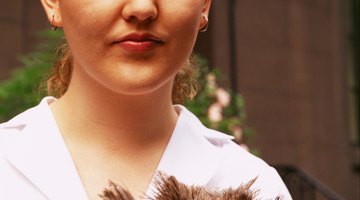Feather Wall Painting Techniques
Table of Contents
You may have heard of feathering your nest, but have you heard of feathering your walls? Feathers dipped in paint and swished over a base coat on the wall can leave a wispy, creative look that wallpaper cannot achieve.

Feather painters often use feather dusters for painting walls, to give a fuller image than a single feather would. A single feather creates fine lines, such as veins in a faux marble wall treatment.
Create A Color Scheme
Feather painting can give you a dramatic effect, or a wispy romantic one. You may want dark feathering on a light wall, or light on dark, or multicolor feathering on a base coat. When you have decided on the look you want, pick colors for your base coat and paint for each shade you want to use for feathering, staying with either all latex, or all oil paints. Make sure to buy a paint tray and a separate feather duster for each color you are using.
Start with the Base Coat
Prepare the room for painting as you would with any paint job, taping off baseboards, edges, door and window frames and covering furniture. Apply the base coat and let it dry thoroughly, according to the paint directions. If you are covering a light wall with a dark color, or vice versa, you may need two coats. When the base coat is dry, you are ready to feather paint.
Practice Makes Pretty
No matter how many colors you are using for feathering, fill paint trays with the respective colors, each about 1/2 inch deep. Practice your painting method on a grocery bag or sheet of butcher paper until you get the knack of just dipping the tip of the feather dusters in the paint, without getting it too thick; then just apply a light wispy image on your practice paper. Soon, you will get the feel for just how much paint you need on your feathers. Use the paper or bag later to wipe off excess paint from your feather dusters.
Feathering in Monotone Color
Dip your feather duster tips into the paint lightly, and then apply the paint to the wall; for instance, silver paint atop dark blue. Blot on a scattered pattern, and then fill in between "spatters" until you like the density of the silver feathering. Another look combines different values of paint in the same color family. For a smart look, use all shades of cocoa, chocolate, caramel and nougat on a taupe wall. For your little girl's room, a pale pink base coat with delicate red feathering would be fresh and pretty. For a sophisticated look, apply almond feathering on a white wall, with just hints of metallic gold. Another option is a high-contrast color scheme. Try a white wall, with only black or chocolate brown feathering. Or, white with red or apple green. You may find you want bigger and more frequent feather spatters with such a simple, high-drama color scheme.
Marble Technique
A feather duster blotted in several similar colors, such as shades of light gray and tan, create color variations for a faux marble technique atop a white base coat. Once the mixed color is blotted on the wall, feather it even more with a dry feather duster or paintbrush. Create the marble veins with a single feather dipped into the vein paint color, such as a dark gray or black, wiggling the feather along rather than painting straight lines.
References
Writer Bio
Linda Johnson is a veteran writer and Photoshop and Illustrator aficionado. She is a TV-radio producer, ad agency owner and a winner of Addy Awards and the First Place Award for Best National Public Service Film. In addition to Johnson's online work, her writing has appeared in "Poetry Guide," the "Indianapolis Star" and Indianapolis Dine magazine.
Photo Credits
- Creatas/Creatas/Getty Images
- Creatas/Creatas/Getty Images
More Articles



